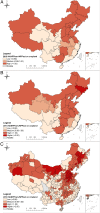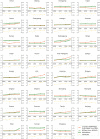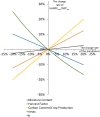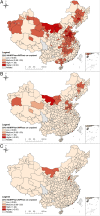On the accuracy of official Chinese crop production data: Evidence from biophysical indexes of net primary production
- PMID: 32978301
- PMCID: PMC7568317
- DOI: 10.1073/pnas.1919850117
On the accuracy of official Chinese crop production data: Evidence from biophysical indexes of net primary production
Abstract
With rapid economic growth and urbanization, self-sufficiency in crop production has become central to China's agriculture policy. Accurate crop production statistics are essential for research, monitoring, and planning. Although researchers agree that China's statistical authority has considerably modernized over time, China's economic statistics have still been viewed as unreliable and often overstated to meet growth targets at different administrative levels. Recent increases in crop production reported by national statistics have also come under increasing scrutiny. This paper investigates crop production data quality from a planetary boundary perspective-comparing net primary production (NPP) harvested obtained from national statistics with satellite-driven NPP estimates that are supported by detailed observation of land cover, combined with observations on physical factors that limit plant growth. This approach provides a powerful means to check the plausibility of China's grain production statistics at different administrative levels that can generate insights about their discrepancies and can contribute to improved crop production measurements. We find some evidence of potential misreporting problems from the lower administration level where the risk of manipulation of statistics is higher. We also find problems from provincial-level major grain producers. These values can also affect the national totals. Although the numbers are affected by large uncertainties, we find that improving the spatial resolution of key agricultural parameters can greatly improve the reliability of the indicator that in turn can help improve data quality. More reliable production data will be vital for relevant research and provide better insights into food security problems, the carbon cycle, and sustainable development.
Keywords: China; HANPP; crop production; statistical data misreporting.
Conflict of interest statement
The authors declare no competing interest.
Figures





Similar articles
-
Is the boom in staple crop production attributed to expanded cropland or improved yield? A comparative analysis between China and India.Sci Total Environ. 2024 Jul 10;933:173151. doi: 10.1016/j.scitotenv.2024.173151. Epub 2024 May 10. Sci Total Environ. 2024. PMID: 38735335
-
Quantifying the impacts of climate variability and human interventions on crop production and food security in the Yangtze River Basin, China, 1990-2015.Sci Total Environ. 2019 May 15;665:379-389. doi: 10.1016/j.scitotenv.2019.02.118. Epub 2019 Feb 8. Sci Total Environ. 2019. PMID: 30772568
-
Pixelating crop production: Consequences of methodological choices.PLoS One. 2019 Feb 19;14(2):e0212281. doi: 10.1371/journal.pone.0212281. eCollection 2019. PLoS One. 2019. PMID: 30779813 Free PMC article.
-
Opportunities and challenges of sustainable agricultural development in China.Philos Trans R Soc Lond B Biol Sci. 2008 Feb 27;363(1492):893-904. doi: 10.1098/rstb.2007.2190. Philos Trans R Soc Lond B Biol Sci. 2008. PMID: 17766236 Free PMC article. Review.
-
Current status and future potential of energy derived from Chinese agricultural land: a review.Biomed Res Int. 2015;2015:824965. doi: 10.1155/2015/824965. Epub 2015 Mar 22. Biomed Res Int. 2015. PMID: 25874229 Free PMC article. Review.
Cited by
-
Exploring the relationships between human consumption and environmental pressure: A case study of the Yangtze river economic zone in China.Environ Sci Pollut Res Int. 2024 Mar;31(13):20449-20460. doi: 10.1007/s11356-024-32476-x. Epub 2024 Feb 20. Environ Sci Pollut Res Int. 2024. PMID: 38374509
-
Air quality improvements can strengthen China's food security.Nat Food. 2024 Feb;5(2):158-170. doi: 10.1038/s43016-023-00882-y. Epub 2024 Jan 2. Nat Food. 2024. PMID: 38168777
-
The contribution of fisheries and aquaculture to the global protein supply.Food Secur. 2022;14(3):805-827. doi: 10.1007/s12571-021-01246-9. Epub 2022 Jan 20. Food Secur. 2022. PMID: 35075379 Free PMC article.
References
-
- The World Bank , Arable land (hectares). https://data.worldbank.org/indicator/AG.LND.ARBL.HA. Accessed 19 February 2020.
-
- The World Bank , Population, total. https://data.worldbank.org/indicator/SP.POP.TOTL. Accessed 19 February 2020.
-
- Brown L. R., Who Will Feed China? Wake-Up Call for A Small Planet, (Norton and Co., New York, NY, 1995).
-
- Gandhi V. P., Zhou Z., Gandhi V. P., Zhou Z., Food demand and the food security challenge with rapid economic growth in the emerging economies of India and China. Food Res. Int. 63, 108–124 (2014).
-
- Xie G. et al. ., The balance between grain supply and demand and the reconstruction of China’s food security strategy in the new period. Ziran Ziyuan Xuebao 32, 895–903 (2017).
Publication types
MeSH terms
LinkOut - more resources
Full Text Sources


